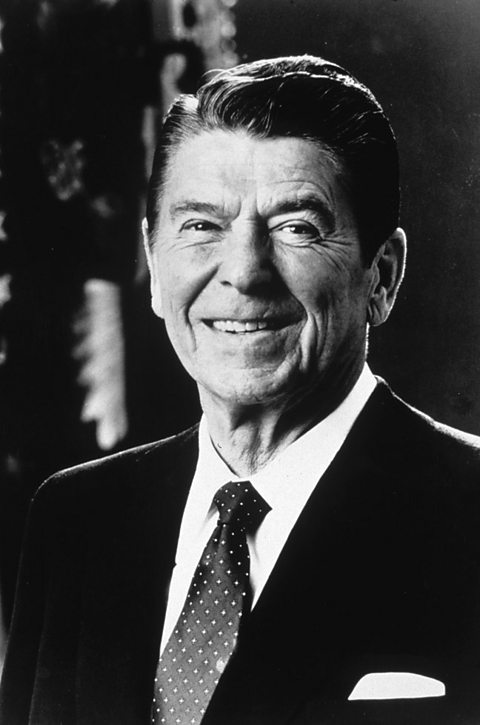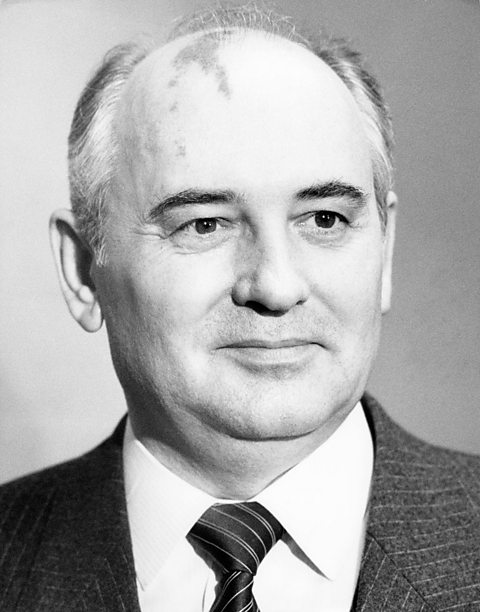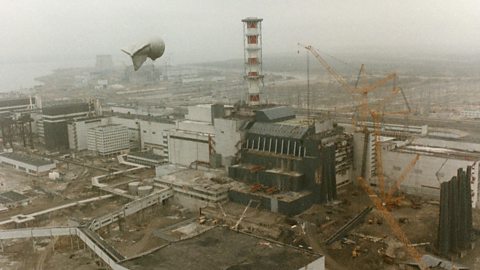The Influence of Ronald Reagan and Mikhail Gorbachev

The last years of the Cold War were overseen by two very different leaders: Ronald Reagan, an ex-Hollywood actor, and Mikhail Gorbachev, a Ukrainian-Russian from a peasant farming background with a law degree from Moscow State University.
Ronald Reagan
In 1980 Ronald Reagan was elected President of the United States (his matching number in Moscow was still the ailing Brezhnev). Reagan was a committed Republican PartyOne of the two major American political parties. Republicans tend to hold a more conservative viewpoint on politics and society. and anti-communistSupporters of the communist movement or party. who, in a speech to the National Association of EvangelicalsChristian group in America who spread the teachings of Jesus., referred to the Soviet Union as ‘that evil empire'.
Reagan increased US defence spending by $32.6 billion and planned to spend it on:
- The Strategic Defence InitiativeAn idea of Ronald Reagan to have a defence shield that would destroy nuclear weapons fired at America. (SDI), nicknamed ‘Star Wars’ after the popular film, was a plan to create a system using satellites and lasers to shoot down any missiles that might be launched by the USSR against the USA. This plan, had it been initiated, would have swung the nuclear balance strongly in the USA’s favour.
- The US military developed a neutron bombA weapon that would kill people without damaging buildings.. The Soviet Union described the neutron bomb as ‘a capitalist weapon’ because it was designed to destroy people while leaving their property intact. While the USSR did not have a neutron bomb of its own, it did upgrade the armour on its tanks and armoured personnel carriers in order to deal with the threat.
The Soviet Union’s economy was struggling and the cost of matching such a programme was too high. They were also very suspicious of the computer-technology that was required to support such a programme and had not invested in it. SDI was the final straw breaker – the USSR could no longer afford to keep up with America in the arms race.
Ronald Reagan explains Star Wars
Ronald Reagan's 'Evil Empire' speech:
So, I urge you to speak out against those who would place the United States in a position of military and moral inferiority… in your discussions of the nuclear freeze proposals, I urge you to beware the temptation of pride – the temptation of blithely declaring yourselves above it all and label both sides equally at fault, to ignore the facts of history and the aggressive impulses of an evil empire, to simply call the arms race a giant misunderstanding and thereby remove yourself from the struggle between right and wrong and good and evil.
Revision tip
When you examine any source, you should consider the historical context and what was happening at that time, as well as looking at the language closely. By March 1983, Reagan had proved he was not going to follow the policy of détente and was more than prepared for a ‘Second Cold War’. What phrases show that he was really committed to this policy?
Mikhail Gorbachev


Mikhail Gorbachev became leader of the USSR in 1985. Under his leadership the USSR slowly began to reform. Gorbachev was an unexpected new leader and relatively inexperienced. He did not speak kindly of Reagan at first, calling him a ‘caveman’. However, several things were about to have a major impact on the superpower relationship:
- Gorbachev famously got on with other world leaders – Margaret Thatcher said:
I like Mr Gorbachev, we can do business together
. Thatcher and Reagan already had a very good friendship and the personal relationships between the three leaders made it easier for the superpowerCountries who have huge influence or strength, giving them significant global power. to maintain diplomatic talks. There was an enthusiastic reaction to Gorbachev’s arrival in many Western countries which was called ‘Gorbymania ’ by the press. - In April 1986, the Ukrainian nuclear power plant at Chernobyl went into meltdown and exploded. Gorbachev approved a cover up that denied there had been any radiation leak but it was clear to Western powers there had been. The cost of containing and decontaminating the area was an estimated eighteen million roubles and almost bankrupted the USSR. Chernobyl was a powerful symbol of the problems in communism.
- Gorbachev’s policies of glasnostOpenness. A policy introduced by Gorbachev to allow more freedom in discussing problems in the Soviet Union. and perestroikaRestructuring. A policy introduced by Gorbachev to allow changes to the way communism worked. (a freer economy including competition and incentives to produce goods) kicked off the slow reform of the Soviet Union’s political system.
- Realising the USSR could never out-spend the USA, Gorbachev began to cut spending on nuclear weapons. He initiated the Strategic Arms Reduction Talks (START) with the USA and in 1987 signed a deal to limit the production of Intermediate Range Nuclear Missiles.
Peace talks and summits
| Talks/Treaties | Presidents/Leaders involved | Outcome |
| Geneva Summit, November 1985 | Reagan and Gorbachev | Both sides wanted to talk peace. Gorbachev hoped to persuade Reagan to drop plans for SDI. |
| Reykjavik Summit, October 1986 | Reagan and Gorbachev | Reagan wanted to get rid of all ballistic nuclear missiles – Gorbachev refused if SDI not dropped. |
| INF treaty, Washington, December 1987 | Reagan and Gorbachev | The Treaty agreed to the elimination all nuclear missiles with a range between 500-5500 km. Stockpiles started to be reduced. Gorbachev knew he didn’t have the money, or defensive reason, to disagree anymore. |
| Malta Summit, 1989 | Bush and Gorbachev | Initial discussion about the CFE and START I agreements. |
| CFE agreement, 1990 | Bush and Gorbachev | Limited the amount of non-nuclear forces NATO and Warsaw Pact could have in Europe. |
| START I, 1991 | Bush and Gorbachev | Limited numbers of most types of nuclear weapons by approximately a third. |
| Talks/Treaties | Geneva Summit, November 1985 |
|---|---|
| Presidents/Leaders involved | Reagan and Gorbachev |
| Outcome | Both sides wanted to talk peace. Gorbachev hoped to persuade Reagan to drop plans for SDI. |
| Talks/Treaties | Reykjavik Summit, October 1986 |
|---|---|
| Presidents/Leaders involved | Reagan and Gorbachev |
| Outcome | Reagan wanted to get rid of all ballistic nuclear missiles – Gorbachev refused if SDI not dropped. |
| Talks/Treaties | INF treaty, Washington, December 1987 |
|---|---|
| Presidents/Leaders involved | Reagan and Gorbachev |
| Outcome | The Treaty agreed to the elimination all nuclear missiles with a range between 500-5500 km. Stockpiles started to be reduced. Gorbachev knew he didn’t have the money, or defensive reason, to disagree anymore. |
| Talks/Treaties | Malta Summit, 1989 |
|---|---|
| Presidents/Leaders involved | Bush and Gorbachev |
| Outcome | Initial discussion about the CFE and START I agreements. |
| Talks/Treaties | CFE agreement, 1990 |
|---|---|
| Presidents/Leaders involved | Bush and Gorbachev |
| Outcome | Limited the amount of non-nuclear forces NATO and Warsaw Pact could have in Europe. |
| Talks/Treaties | START I, 1991 |
|---|---|
| Presidents/Leaders involved | Bush and Gorbachev |
| Outcome | Limited numbers of most types of nuclear weapons by approximately a third. |